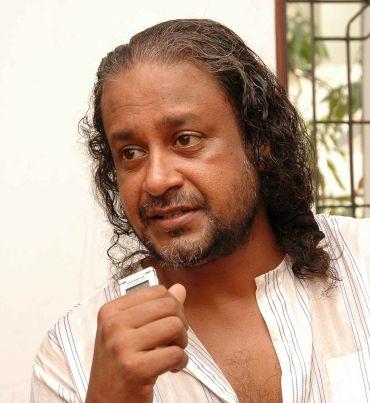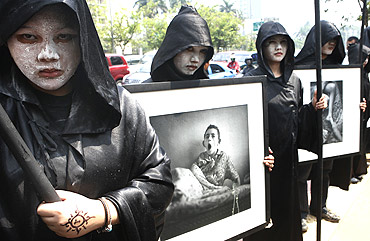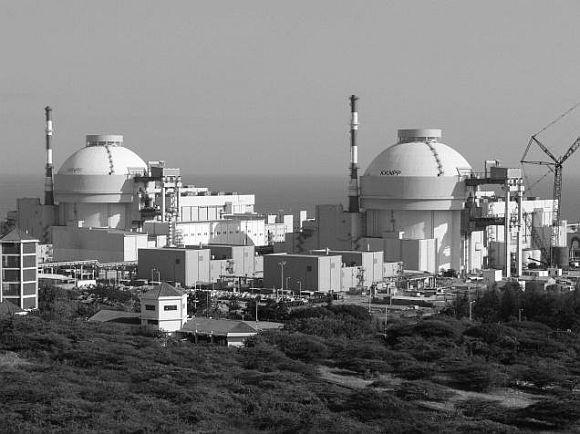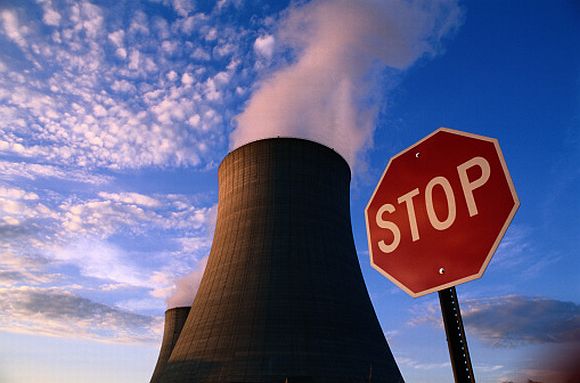 | « Back to article | Print this article |
'Nuclear power plants pose unmanageable risks'
When dealing with risky technology, it is most important to take people into confidence and tell them what the real risks are, says activist Nityanand Jayaraman.
Nityanand Jayaraman, an environment justice activist and a lecturer at the Asian College of Journalism on environmental journalism, is at the forefront supporting the Koodankulam nuclear power plant agitation through the Chennai Solidarity Group for Koodankulam Struggle.
In an interview with rediff.com's Shobha Warrier, Jayaraman talks about why he supports the agitation and why all nuclear power plants in India have to be shut down.
Why do you support the agitation against the Koodankulam nuclear power plant?
I have an issue not only with the Koodankulam power plant but nuclear power per se. I think all technologies come with risks, and some risks are manageable, so we take those risks. But some risks are unmanageable and those risks should not be taken.
You mean nuclear power plants pose unmanageable risks?
Yes, nuclear power plants pose unmanageable risks. You have seen it time and again; the Kyshtym disaster in the 1950s, Three Mile Island in the 1970s, Chernobyl in the 1980s and Fukushima in 2011. We have seen that engineers, technocrats and politicians across nations have been unable to handle the fallout. It is not just the lack of faith in the Indian engineers but the unmanageability of the technology itself.
Not everything in nature can be controlled at all times. Perhaps a time will come when human beings will be able to subject the atom to their will.
It is wrong to subject communities and future generations to this kind of a risk.
Click NEXT to read further...
For Realtime News on Koodankulam nuclear power plant, click here
'Devious to suggest nuclear disasters caused only 30 deaths'
What are the risks according to you?
Risk of an explosion cannot be ruled out. The fall out of an explosion cannot be managed.
Nuclear scientists say that in its long history only 31 people died because of an explosion, and that was at Chernobyl...
Besides the better known disasters at Kyshtym in the erstwhile USSR, in 1957, Three Mile Island in 1979 and Chernobyl in 1986, there are 76 other accidents. 56 accidents occurred after Chernobyl. Damages were worth $19.1 billion (Rs 101,230 crore) between 1947 and 2008. This translates into one serious nuclear accident every year causing $332 million (Rs 17,596 crore) in damage.
What about the loss of human lives?
Uncountable. We are not talking about immediate deaths. Bhopal tragedy caused 8,000 deaths immediately. But those who lived say those that died are the lucky ones. The unfortunate ones survived and they are dying long, painful, lingering deaths.
Similarly, talking about 30 deaths, etc. is extremely misleading. This is why I am particularly scared of Indian scientists. The cost of a disaster other than human pain and suffering is the long term environmental and economic damage. The total cost of the damage will run into hundreds of millions of dollars.
Take the case of Belarus, the neighbouring state worst affected by the Chernobyl disaster. I will quote from a report by the International Atomic Energy Agency. Between 1991 and 2003, Belarus spent $13 billion (Rs 68,900 crore) on disaster related expenses. Ukraine, the country where Chernobyl is located, still allocates 6-7 per cent of the government's total spending for disaster rehabilitation.
Radiation contamination because of the disaster extends to 200,000 sq km mostly in Russia, Ukraine and Belarus. 200,000 sq km is roughly the size of Tamil Nadu. In the case of a disaster at Koodankulam, it will be passed on to the ocean, Sri Lanka and Kerala.
A multi-agency study done by World Health Organisation says that there were more than 5,000 cancer related deaths at Chernobyl. In Fukushima, people are facing thyroid problems. You say nobody died in Fukushima but you check and see how many are suffering due to illnesses related to radiation. Not to forget the psychological trauma because of the inability to return home, inability to resume normal lives, inability of children to go back to the playgrounds.
If people think that life is all about life and death, they are so mistaken. I find it quite devious to suggest that nuclear disasters caused only 30 deaths.
Click NEXT to read further...
'Nuclear establishments have converted the practice of lying into a fine art'
Nuclear scientists say that nuclear energy is the only option India has considering its needs...
Nuclear energy contributes a minuscule part to India's power generation; less than three per cent. In 1962, Homi Bhabha said, nuclear energy is the future. In 1972, Vikram Sarabhai said the same thing and he also said from that year onwards India would add 500 MW every year and bring it up to 20,000 MW. That promise never materialised until 1986 when the first 500 MW power plant was built.
After 60 years of promises and precious money being sunk into nuclear power plants, we still have less than three percent of the total power generated from nuclear energy. This is something brought up by the Controller and Auditor General that Rs 5,295 crore was spent with nil electricity to show.
We had the promise of the Prototype Fast Breeder Reactor at Kalpakkam. There are no agitations going on there. There are no communities holding it to ransom but there has been cost overrun, immense delay and it was supposed to have been commissioned in March 2012. Are they anywhere close to commissioning?
I think the nuclear establishment is the most prevaricating establishment the world over and particularly so in India. They have converted the practice of lying into a fine art.
When the nuclear establishment says that it is the power of the future, I seem to have heard it before -- Dr Bhabha saying it, Jawaharlal Nehru saying it, Dr Sarabhai saying it and Dr A P J Abdul Kalam saying it. Ten years down the line, another person will say it.
Another argument is that there is already a nuclear power plant in Tamil Nadu at Kalpakkam. Why the resistance to Koodankulam?
If you ask me, the Kalpakkam power plant has to be shut down as well.
What about the 20 other nuclear power plants in India? Scientists say so many people live around those power plants without any complaints and none is affected by any of the plants.
That is lie number two. In 1987, there was a refuelling accident that ruptured the reactor core at Kalpakkam. In 1991, workers were exposed to radioactive rays. In 1999, 42 workers were exposed to radiation. In 2002, 100 kg of radioactive sodium was released into the environment. In 2003, six workers were exposed to high levels of radiation and three of them died.
Other serious incidents have happened at other reactors too. One of the reasons why these reactors are running safely is secrecy. Remember the tritium leak. When people drank water that had tritium near the Kaiga power plant, the world came to know after seven days when the news was broken by a newspaper. Then they said it was sabotage by an outsider.
Every single power plant site is a massive protest area. In all these places, we see the State against the people and it is happening in a democratic country.
When you are dealing with a risky technology, what is most important is to take people into confidence and tell people what the real risks are.
Click NEXT to read further...
'There is a clamp down on free speech'
The prime minister said that foreign hands are behind the agitation against the Koodankulam power plant and they want to sabotage the plant...
It is very easy to make those allegations. I can also prove that there is a foreign hand working in Koodankulam and that is Russia. If there was really a foreign hand behind the agitation, why is it that it was not proved and no one is jailed?
Dr Kalam, who is admired by all Indians, said a few weeks ago that nuclear energy is the safest and all the nuclear power plants including Koodankulam are safe. He went there and spoke to people and tried to allay their fears.
After what he said at Koodankulam, I would be cautious to use the word scientist to describe him. The kind of statements he made fall more in the realm of astrology than science. What it does is it lulls people into complacency.
If the people of that area had believed him, they would have abandoned their protests. People who are not educated managed to retain their common sense. These people cannot be convinced by empty words of the highly educated people. They need explanations. They have very legitimate fears. They have to be taken into confidence and explained the risks so that they can be prepared. It is important to get the acceptance of the local people. It goes for not only nuclear power plants but all other technologies as well.
Now that the chief minister of Tamil Nadu is going ahead with the power plant, what will happen to the agitating people and the agitation itself?
I don't know.
In what way are you supporting it from Chennai through the Chennai Solidarity Group for Koodankulam Struggle?
I talk about it to young people and the media. I write about it. I also work with other people who are in solidarity with the struggle in organising press conferences. We also collect money and give it to the agitating villagers.
Right now there is a clamp down on free speech; it is no longer about nuclear power plants. This is an issue of democracy vs anti-democracy.
Click NEXT to read further...
'Certain sections of the media colluding with the state'
Clamp down on free speech in what way
In various forms. On the Koodankulam issue, the Tirunelveli district is functioning under a different regime that is not as per the Constitution of India. Idinthakarai today remains an open prison; people can go in but the local villagers cannot come out. There are close to 57,000 cases filed against these people in one police station. These include cases of sedition or waging war against the state.
Halls are denied to people who want to hold meetings critical of the plant. No printing press is willing to print wall posters against the plant because police question them. Demonstrations against nuclear energy are not permitted in Tirunelveli. False cases are being foisted on people like Udayakumar (social activist who led anti-nuclear power plant protests at Koodankulam).
So, we have quite an explosive and dangerous situation there. We see a certain section of the media colluding with the state.
Have you received any threat because you are supporting the agitation?
No, I have not received any threats.
From June, the government says the plant will start functioning and generating power. After that, in what way do activists like you plan to support the agitation?
It is not merely about Koodankulam. Our struggle is against nuclear energy, it is about right to express oneself. I am not too worried about June 2012. Going by the track records, I am quite certain it will not happen in June.
What I am concerned about is, if they are indeed serious about commissioning it in 2012, they ought to be following the guidelines of the International Atomic Energy Agency. They are part of the convention. It says mandatory drills on disaster management must be conducted in the villages. That is not being done yet.
Our ultimate fight is for the shut down of the nuclear power plants. But our requests are not respected.
If they say nuclear power is safe and they have taken all precautions, then I have a case here. All precautions are not taken here. They have not conducted drills and are not even showing people where to run to in case of an emergency. Which hospital can handle these many people? Where are the shelters? If something happens in two years' time, what will happen to the people?
This will keep us occupied till the pant is commissioned. Someone's greed for power cannot be at the cost of some others' lives.
TOP photo features of the week
Click on MORE to see another set of PHOTO features...





